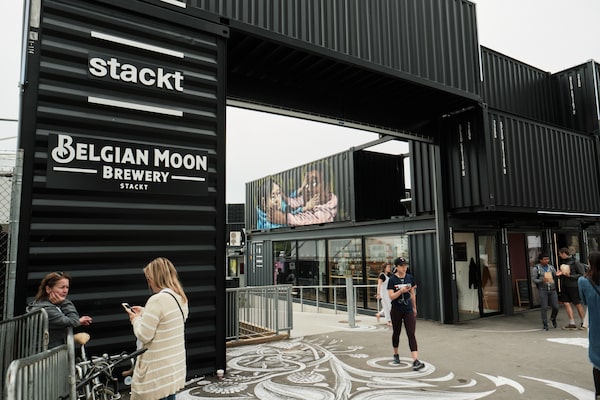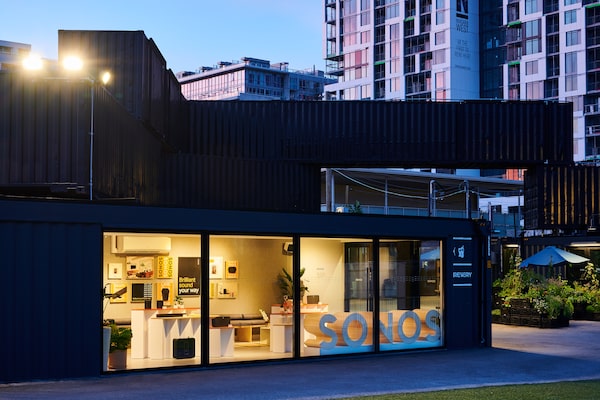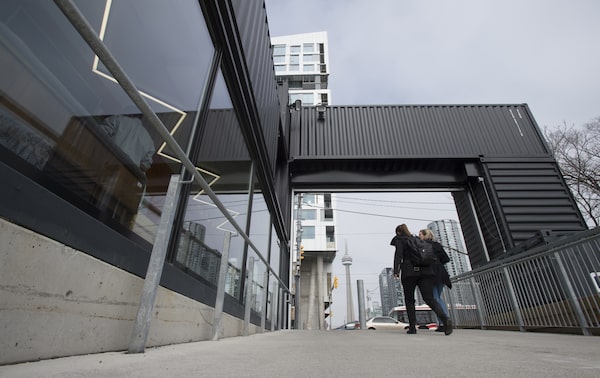The proposed City of Toronto affordable housing complex, rendering seen here for 150 Harrison St., Toronto, will be built using modular construction techniques.Montgomery Sisam Architects Inc.
Compared to the normally sluggish pace of most construction projects, the development of two new City of Toronto affordable housing complexes will have a kind of don’t-blink-or-you’ll-miss-it quality.
The projects – one in the west end and the other in Scarborough, and both designed by Montgomery Sisam Architects (MSA) – will have 44 and 56 units respectively. Each 250-sqaure-foot studio contains a single main room, a kitchen and a bathroom, and is intended as housing for a currently homeless individual.
Their most distinctive feature, however, is mainly invisible: both are being built using “modular construction” techniques, with each apartment unit assembled entirely in a Grimsby, Ont., factory, transported to Toronto and craned into place like so many Lego blocks. From site preparation to occupancy this fall, they’ll each take about four months to complete, says Daniel Ling, a principal and director with MSA. A similar undertaking using conventional construction methods would drag on for 12 to 18 months, he adds. “It’s a very significant time savings.”
While these proposals, which received a green light from Toronto council this week, have been the target of some NIMBY grumbling, they’re also drawing attention to the potential for modular and prefab development in a city where construction sites, with all their familiar disruptions, can persist for years.
But besides speed, proponents of this approach also point to other benefits, including improved energy performance, smaller carbon footprints, reduced cost and more consistent quality control.
Another proposed housing complex, rendering seen here of 11 Macey Ave., Toronto, will take about four months to complete.Montgomery Sisam Architects Inc.
Countries such as India, China and Finland have shifted their construction sectors to far greater reliance on prefabricated building components, while in Hong Kong, local authorities won’t issue a building permit to developers who can’t demonstrate that some elements of their proposed projects are factory built, according to University of Alberta professor of construction engineering Mohamed Al-Hussein, who has advised on prefab apartments that were completed in weeks.
In British Columbia, provincially funded affordable housing projects are now mandated to use modular design; indeed, Mr. Ling says the two Toronto projects rely heavily on designs that have been tested in 30 such apartments, several built by Calgary-based Horizon North, a modular manufacturer.
The domestic market for factory-made components has not only grown sharply in the past decade, but is attracting new entrants. The number of certified producers in Canada jumped from 85 to 147 between 2009 and 2020, while 36 importers – mostly American and Chinese – now sell into the Canadian market, according to data compiled by the Canadian Home Building Association (CHBA).
One Alberta homebuilder, Landmark, now produces all of its dwellings in an automated 150,000-sq.-ft. Lethbridge factory owned by ACQBuilt. The London, Ont.-based construction giant Ellis-Don is in the midst of constructing a 300,000-sq.-ft. factory in Hamilton that will pump out steel-frame prefabricated modules.
Modular construction techniques, like the ones used at 11 Macey Ave., are beneficial in lowering carbon footprint and improve energy performance.Montgomery Sisam Architects Inc.
Meanwhile, Element5, a five-year-old mass timber start-up armed with $10-million in venture capital backing from Kensington Capital Partners, is building a 120,000-sq.-ft. plant in St. Thomas, Ont. Using automated production equipment supplied by Ledinek, a Latvian firm, Element5 will turn out engineered beams and wall assemblies from wood processed in a pair of Northern Ontario saw mills, founder Patrick Chouinard says. “We’re in this revolution in the construction industry.”
The revolution has been notably slow to start. In contrast to the global manufacturing sector, which shifted aggressively to just-in-time supply chains and automation three decades ago, the Canadian construction sector has been sluggish to modernize, with the result that projects are delayed because of perennial scheduling conflicts involving skilled trades, sub-contractors and municipal inspectors.
But in recent years, says Kathleen Maynard, CHBA senior director for building innovation, worsening labour shortages among electricians, plumbers and carpenters has forced construction companies to turn to prefabricated components, from retrofitted shipping containers to roof assemblies and completely framed wall panels fitted out with doors, windows, insulation and exterior cladding.
Lassonde Engineering Faculty temporary pavilion, concept design rendering by LGA Architectural Partners.LGA Architectural Partners
The shift to factory-made elements typically means safer working conditions and less waste. Prof. Al-Hussein’s research has also shown substantial reductions in not only idle time, but also wasted drywall, cardboard and other building materials.
The result, Mr. Chouinard says, is that construction costs can come in 5-per-cent to 20-per-cent lower than conventionally built structures. “The motivation for the developer is that they can build it cheaper and faster.”
While early demand for prefab units typically came from builders of cookie-cutter single-family homes, Ms. Maynard says more than 80 per cent of the production now finds its way into affordable housing, apartment buildings and offices. Mr. Chouinard’s firm is one of several aiming to tap into demand for mid-rise post-and-beam office buildings made from engineered wood. “That’s the sweet spot,” he says.

Stackt Market, a modular market in downtown Toronto, offers retail and community spaces within roughly 120 shipping containers.Patrick Leung/Handout
LGA principal Janna Levitt, whose firm designed Stackt Market, a shipping container complex in downtown Toronto, also points international examples, including boutique hotels, student residences and all-wood apartment buildings, as proof that modular structures are becoming less utilitarian and more suitable for innovative design.
LGA is currently working on a small prefab arts and recreation facility situated in the middle of an Etobicoke park. The project, MabelleArts, is linked to a nearby affordable housing complex. Ms. Levitt says the motivation was to erect the small building without overrunning a busy park with construction equipment.

Speaker brand Sonos opened its first Canadian retail space in Toronto at the Stackt Market.ARASH MOALLEMI/Handout
As for the two Toronto affordable housing sites, the approvals process was sharply accelerated after a spate of COVID-19 outbreaks in homeless shelters forced the city to scramble to find alternatives.
With construction crews set to begin building the foundations and elevator shafts in the next few weeks, skilled trades at the Grimbsy plant will start erecting the 100 units, which will be hauled on flatbed trucks to Toronto later in the summer. “Everything is installed in the shop,” says Mr. Ling, the architect. Once they’re lowered into place, the landscape will be completed and the apartments turned over to the new occupants. “It’s pretty simple and straightforward.”
The Pre-fab Myth
The “myth” of prefab buildings, LGA partner Danny Bartman says, is that such structures can be essentially snapped together. That 1950s-vintage idea, he says, obscures the nuanced technical realities of the modular sector.
Components can range from simple exterior wall assemblies to so-called “volumetric” units that include everything from cladding to interior finishes and appliances, and can only be shipped on a wide-load truck.

Building and constructing Stackt Market required thinking backwards, senior project manager Cara Grant says.Frank Gunn/The Canadian Press
The designers and construction managers must collaborate to figure out how to put together the prefab elements in the most efficient way. “If we’re fully aligned with the factory, they’ll be comfortable with plug and play,” says Mr. Bartman, who designed a roof-top modular addition to an affordable housing complex operated by St. Clare’s, a Toronto non-profit.
Cara Grant, a senior project manager at Ellis-Don, oversaw the construction of the Stackt Market. “I had to think backwards about how we were going to build it,” she says. The process involved refining the interior design of each container, staging their arrival and finally knitting the whole complex together with plumbing, electrical systems and landscaping.
Unlike more conventional development projects, Ms. Grant adds, “it’s very important that the construction manager participate from the beginning with the design team and the owner. It has to happen together to make it work.”

Pre-COVID city views from the Stackt Market.PATRICK LEUNG/Handout
Your house is your most valuable asset. We have a weekly Real Estate newsletter to help you stay on top of news on the housing market, mortgages, the latest closings and more. Sign up today.